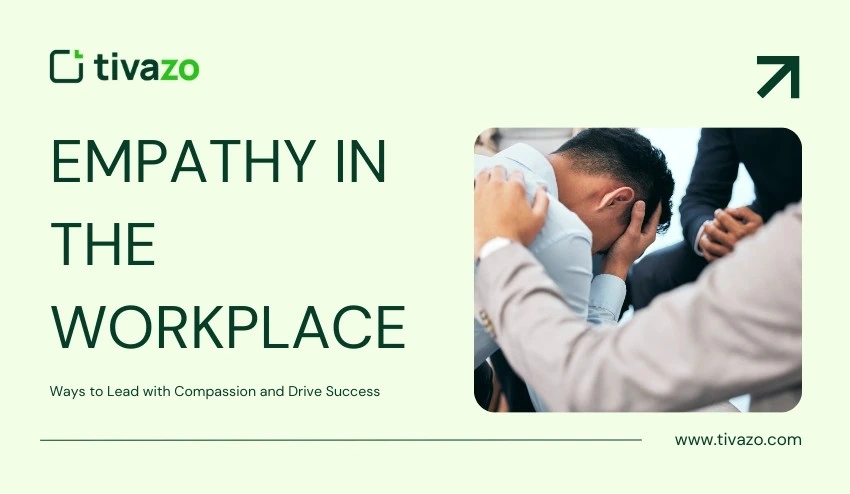In the current competitive business environment, empathy at work is no longer seen as a “nice-to-have” trait, it is a leadership competency that contributes to employee engagement, increases performance and productivity, and leads to greater success for the organization as a whole. Whether you are a manager or a team leader, demonstrating empathy at work will promote stronger relationships, build a collaborative culture, and even lead to better retention.
But what is empathy, and why is it significant when it comes to the workplace? In the current competitive business environment, empathy at work is no longer seen as a “nice-to-have” trait, it is a leadership competency that contributes to employee engagement, increases performance and productivity, and leads to greater success for the organization as a whole. Whether you are a manager or a team leader, demonstrating empathy at work will promote stronger relationships, build a collaborative culture, and even lead to better retention.
In this blog, we will review 7 ways to effectively use the power of empathy to follow through with employee’ morale, impact workplace success, and enhance a positive work culture.
Key Highlights:
- What is Empathy in the Workplace
- Power of Empathy for Employee Engagement
- Powerful Ways to Lead with Empathy
- Measure Empathy in the Workplace
- Empathy and Employee Engagement
What is Empathy in the Workplace?
Before we get to the things you can do, let’s first discuss the idea of empathy in the workplace. Empathy is not feeling for (sympathy), it is understanding and reacting appropriately to that person’s emotional state.
In simple terms:

- Cognitive Empathy– Understanding what a person is experiencing.
- Emotional Empathy– Identifying with what a person is feeling, and responding with compassion.
The science backs this up, too. Empathy in the workplace releases oxytocin, associated with bonding and trust, and this leads to effective communication and collaboration in the workplace.
The Power of Empathy for Employee Engagement
Elevating employee engagement relies on high levels of empathy in the workplace. Employees perceived as “seen” are more engaged, motivated, and inventive. Empathetic leaders connect with associates on a human level, creating an emotional connection that reflects an investment in the organizational goal of success.
Did you know?
- Employees with empathetic leaders are 61% more likely to be innovative.
- 86% of employees report a better work-life balance when they are led by empathetic managers.
But empathy is not simply about hitting goals; it’s creating a culture where all employees feel valued and respected and engaged with the mission and goal of the organization. This will lead to more motivated employees, greater productivity, and longer-term engagement.
7 Powerful Ways to Lead with Empathy
Now that we know why empathy is important, let’s look at the 7 ways to lead with empathy in the workplace.

1. Lead by Example: Walk the Talk
Empathy in the workplace starts at the top with its leaders. As a leader, you create the climate for your team. If you want your employees to have empathy, you must demonstrate empathy every day, in the way you act. Employees are much more likely to have behavior modeled by their leaders. Leaders who are transparent and vulnerable and show their human side create a climate of trust and inspire others to do the same.
- Be open about your own challenges, feelings, and goals.
- Be willing to show your vulnerability when appropriate and demonstrate it’s okay to not always have the answer.
- Engage fully in dialogue; you’ve probably heard it before, but your body language speaks volumes.
2. Master the Art of Active Listening
Listening actively goes beyond simply hearing words; it means being present, open, and attuned to the speaker’s perspective, thoughts, emotions, concerns, and needs. Actively listening helps connect with the speaker and build rapport with employees. When you understand employees on this level, you are better equipped to support them and to make informed decisions.
- Ask follow-up questions to communicate that you are engaged in the conversation.
- Try not to interrupt; allow the other person to fully explain their point of view.
- Summarize their feelings by saying something like, “It sounds like you’re feeling frustrated with this situation.”
3. Foster a Safe Space for Communication
Employees need to feel safe to truly contribute and share their thoughts with you or others in the organization. If you cultivate a culture in which employees feel comfortable communicating their concerns openly, without judgment or repercussions, you will have created clear channels of communication. This can lead to better understanding, less misunderstanding, and meaningful connections.
- Encourage employees to have open conversations about ideas, challenges, and feedback.
- Try not to be judgmental in your responses so employees feel accepted.
- Create anonymous constructive feedback forums for employees to share their opinions more freely and without fear.
4. Implement Empathy in Conflict Resolution
Conflicts are a part of every workplace, but it is the way you deal with them that has an impact on the team dynamic. Instead of pointing fingers, use empathy to deal with conflict by seeking to understand everyone’s point of view. This will help you intervene in a more effective way and find solutions that will benefit everyone and improve team efficacy.
- Hear both sides of the conflict before intervening.
- Recognize feelings without agreeing or disagreeing with the argument.
- Limit focus to the problem itself and not additional underlying issues.
5. Recognize and Celebrate Employee Achievements
Empathy in the workplace is not just about when an employee is struggling; it is about acknowledging when they are having a triumph. Showing thanks and recognizing hard work and celebrations are all part of making and maintaining a positive working environment. This will support employees in feeling recognized, valued, and motivated to continue improving.
- Provide praise personalized to the employee, based on their strengths and contributions.
- Celebrate small and big wins, completing a project or helping a colleague.
- Swag a well-deserved public shout-out at team meetings or through company communications.
6. Prioritize Employee Well-being and Mental Health
As a leader with empathy, it is important to demonstrate that you care about the employee’s well-being as a whole. Encourage the conversation around mental health, provide a flexible work environment, and encourage a work-life balance. When employees know that their emotional health is valued, they feel like they belong and are more likely to remain loyal and engaged with the organization.
- Offer flexible work hours or remote work options as needed.
- Provide access to mental health resources such as counseling or support groups.
- Encourage regular breaks and time off to avoid burnout.
7. Provide Empathy Training for Leaders
Empathy in the workplace is a skill that can be learned and developed. Training your leadership team on empathy in a large organization is essential to progress empathy at scale. Workshops, role playing, and continuous feedback utilize empathy training to foster empathic leaders across all levels, thereby creating a more empathetic workplace culture.
- Encourage leaders to engage in peer learning by sharing best practices in the method of empathetic leadership.
- Implement regular ongoing empathy training workshops, and continually provide training workshops with role-playing and real-life situations.
- Create feedback systems to provide constructive feedback for leaders’ empathetic behavioral practices.
The Science Behind Empathy: Why It Works
Empathy is not just a nice-to-have notion; it is scientifically proven to improve business performance. When leaders exhibit empathy in the workplace, they strengthen relationships, stimulate innovation, and create a high-performing work environment. Empathy transforms the business by building trust. Trust is a prerequisite for any high-performing organization.
- Neuroscience: Empathy activates our brain’s mirror neurons, which allow us to connect with others emotionally.
- Psychology: When employees feel emotionally safe, they will take risks, voice unconventional ideas, and collaborate with others without hesitation
How to Measure Empathy in the Workplace
Now it might seem subjective, but you can measure empathy effectively in the workplace. Here are some ways to measure empathy in the workplace:

1. Employee Feedback
The easiest and most direct way to measure empathy is through employee feedback. Use regular surveys, confidential one-on-one meetings, or anonymous polls to allow employees to share candid feedback without fear of judgment. Where empathy in the workplace is evident, you should see positive feedback about leaders listening, being understanding, and being supportive.
- You can also use Pulse Surveys as a formal way to collect real-time feedback.
- Additionally, look for trends referenced in the comments surrounding leaders being approachable, understanding, and trusting.
2. Engagement Metrics
Empathy has a significant effect on employee engagement. When individuals feel like they are heard and supported, their commitment to their work increases. Elevated engagement and decreased absenteeism are clear signs of a strong, empathetic workplace culture. Employees feel safe and valued are more present, improve their performance, and stay on task.
- Engagement scores are available to be tracked in tools like Officevibe or 15Five.
- Track absenteeism if it drops; empathy may have contributed to this.
3. Retention Rates
Empathy in the workplace significantly influences retention rates. When employees feel cared for emotionally and their well-being in the workplace is acknowledged, employees stay in their positions longer. A high retention rate is indicative of a strong workplace culture designed by leaders who have created a culture where employees feel seen, heard, and appreciated.
- Examine turnover data, comparing turnover rates with employee satisfaction scores.
- Conduct exit interviews to determine whether empathy (or lack of empathy) influenced a decision to leave the workplace.
Overcoming Barriers to Empathy in Leadership
While empathy is a strong influencer, it is not always easy to develop. Leadership has some remarkable challenges that inhibit empathy:

1. Time Constraints
Leaders may often feel as if there is no time to learn about an individual employee or develop relationships. The weight of deadlines and performance drives leaders away from assessing emotional needs.
- Simply schedule check-ins every week or develop brief one-on-one meetings to create time for empathy
2. Emotional Fatigue
Being in a role that constantly has to support employees can drain the leader quickly. If the leader is drained, it is difficult to show up and demonstrate empathy in the workplace.
- Prioritize self-care for yourself and promote emotional breaks. Delegate the workload to prevent the overload of tasks.
3. Biases
Every individual has personal biases, conscious or unconscious, informing decisions that we would consider truly empathetic. If a leader’s bias clouds their judgment, their ability to be empathetic can wane.
- Continuously engage in bias training and establish a culture of inviting perspectives that creates an open, inclusive environment.
To combat the barriers above, it is essential to have systems of support, practice self-care, and engage in the development of ongoing empathy training.
Empathy and Employee Engagement: A Powerful Combination
When empathy and employee engagement work together, they create a combined effect that is favorable for both the employees and the company. Engaged employees are emotionally engaged in their work, and empathy in the workplace fuels emotional connection.

1. Increased Job Satisfaction:
Empathy lets the employee feel valued and acknowledged, which allows for greater job satisfaction. When people believe their leaders are genuinely concerned for them as individuals, it increases their likelihood of putting more into their jobs.
Example: Employees who feel heard and given support will contribute to performance above and beyond what is written in their job description.
2. Higher Productivity:
When employees feel emotionally supported and engaged, focus and productivity improve. Empathy in the workplace creates an ease by removing emotional barriers such as stress or frustration, allowing employees to focus on performance.
Example: When team members report to a leader who exhibits empathy, they report a 25% increase in productivity simply because they feel safe taking risks and are committed to making decisions.
3. Enhanced Creativity and Innovation:
Engaged employees will tend to think creatively, be predisposed to suggest a creative approach, and feel confident in sharing their ideas. Empathy helps to create a workplace that fosters psychological safety around creativity.
Example: A tight-knit team culture within a company has a higher likelihood of team collaboration on a creative solution, resulting in a new idea, product, or service.
4. Stronger Connection to Company Goals:
Employees who feel both engaged and empathetic have a stronger emotional connection to the organization’s mission, leading to deeper loyalty and less turnover.
Example: When employees understand their operational purpose based on the “why” behind the mission of that organization, they feel a sense of purpose in wanting to make their best contribution.
Conclusion: The Future of Leadership Is Empathy
Empathy in the workplace is being recognized as the new essential capacity for effective 21st-century leadership practices. Leaders who practice empathy are, by definition, establishing a community of trust and understanding, leading to greater employee engagement, innovation, and loyalty. All of which may be leading indicators of success in an organization.
In the future, empathy will provide the foundation for developing skilled, stable, and adaptable employees. There is no failure to act on empathy in your organizational leadership framework that will deliver greater productivity and engagement in a process, which may create a more connected, committed workforce.




